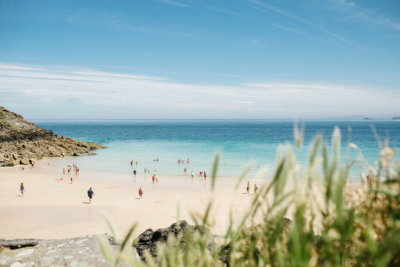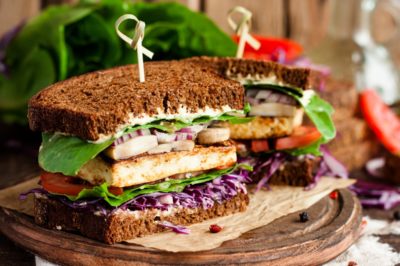Fish are inextricably tied to the water and literally suffocate in air. Here’s why eating fish instead of meat isn’t the kinder option.

Is fish farming cruel? Do fish even feel pain? These harmful myths about fish persist despite plenty of evidence proving their intelligence and capacity to suffer.
‘We wouldn’t accept killing chickens by throwing them into a tank of water and waiting for them to drown, so why don’t we object to fish suffocating on trawler decks?’ says Victoria Braithwaite, Professor of Fisheries and Biology at Penn State University and author of Do Fish Feel Pain.
How are fish caught in the wild?
Netting can capture tens of thousands of fish at one time, with animals becoming exhausted as they desperately try to outswim the net.
When the nets are pulled to the surface, those at the bottom are crushed by the weight of fish above them. The rapid change in pressure causes their swim bladders to overinflate, and their stomachs and intestines to be pushed out through their mouths and anuses.
Their eyes distort, bulge and can also be pushed out of their sockets.
The animals are then dropped onto the ship’s deck where those who are still alive will suffocate – a process that can take several minutes. Others, like tuna, are hoisted from the water with a hook, and killed by forcing a spike through their brains.
Despite an ever-increasing number of studies that show aquatic species can feel pain, there are no still welfare laws governing the slaughter of fish at sea.

Overfishing causes habitat destruction
Industrial fishing is wreaking havoc upon our oceans. Three-quarters of fish stocks are overexploited in the European Union.[2]
The number of cod, plaice and sole have declined by 32 per cent in EU fisheries since 1993. Around 63 per cent of the assessed ‘stocks’ in the Atlantic, 82 per cent in the Mediterranean and 66 per cent in the Baltic are overfished.[3]
Tuna, cod, swordfish and marlin populations have declined by 90 per cent during the last century, while the North Sea mackerel population, which collapsed in the 1970s, has never recovered.[4] This is just the tip of a devastating iceberg.
Habitats are decimated by the industrial fleet of fishing ships. Bottom trawling strip mines the ocean floor, destroying deep-sea coral forests and other delicate ecosystems.
Many scientists believe that the impact of fishing on bottom-dwelling animals is 100,000 times greater than seabed oil or gas extraction[5] and yet environmentalists all too often continue to eat fish, thereby contributing to this devastation.
With one in three fish caught in the wild being used for non-human consumption,[6] including the fishmeal that is added to farmed animal feeds, eating meat also contributes to the damage done to the oceans.
Watch this powerful video about the effects of overfishing on our oceans and marine life:
What is bycatch?
Nets do not discriminate. They will drag any species out of the water, whether they are commercially valuable or not.
There are no numbers recorded of either fish or ‘bycatch’ caught. Instead, the industry records weight. The weight of fish and other forgotten fish species caught as bycatch each year is estimated to be more than 20 million tonnes, almost a quarter of all marine species landed.[7]
An estimated 300,000 whales, dolphins and porpoises die in fishing nets every year.[8] Other bycatch species include sharks, turtles, starfish, sponges and hundreds of thousands of diving seabirds[9], among them albatrosses.

Is farming fish the solution?
Farming fish is not the answer to the wanton environmental destruction of sea fishing. For one thing, farmed species such as salmon, halibut and cod are carnivores so are fed fish taken from the oceans, thereby exacerbating the destruction.
Fish farming also directly impacts the health of wild fish. This is because farmed fish escape and spread diseases and sea lice among their wild counterparts.
Sea lice cause inflammations and haemorrhages and attack the fish’s organs, eventually eating them alive.
The lice from farmed salmon are now spreading to wild populations of fish in parts of the North East Atlantic, while pesticides used to control sea lice in fish factory farms are proving harmful to wild fish populations.
Animals suffer on fish farms
Fish are packed into unnatural small, filthy enclosures. The overcrowded conditions cause a third of them to die, and an array of chemicals are used to try to prevent even more from dying.
In this stressful environment, many fish will bite off the fins, tails, and eyes of others, a distressing behaviour seen in other factory farmed animals.
Philip Lymbery, Chief Executive of Compassion in World Farming, explains that salmon as big as three-quarters of a metre long can each be allocated the equivalent of a bathtub of water. ‘Packed tightly, these ocean wanderers swim as a group, or shoal, in incessant circles around the cage, like the pacing up and down of caged zoo animals.’[10]
Often the cruelty is deliberately inflicted. Shrimps and prawns, for example, are blinded because most of those reared in captivity aren’t able to reproduce, and having their eyestalks cut off triggers the maturing of their ovaries.
‘Eyestalk ablation’ has been labelled ‘cruel’ and ‘traumatic’ by numerous scientists but it won’t stop – it is an intrinsic part of shrimp farming and more than half of all shrimps consumed globally are farmed.
Farming fish may eradicate the problem of bycatch, but it does not mean there are no additional victims. The Scottish fish farming industry admits to shooting 500 seals a year to prevent them from eating the fish, but campaigners say the real figure could be as high as 5,000.[11]
How are fish transported?
Transporting fish is a stressful and painful experience for them. They may be injured when caught by the vacuum pumps and nets, and suffer as they undergo changes in water pressure and temperature.
It is common practice to starve fish for 48 hours before transporting them to slow down their metabolisms and reduce the contamination of the transport water from their faeces. Some fish may even be kept out of the water during the transport period.
Slaughter
The only legal stipulation for slaughtering the tens of millions of farmed fish who are killed in the UK each year{12] is that they be ‘spared any avoidable pain, distress or suffering’.[13]
Fish on farms may be killed by asphyxiation or they may have their gill arches torn, an inhumane procedure that causes the animals to struggle violently for the four minutes it takes for the fish to die.[14]
Some fish are stunned before slaughter by a blow to the head, electrical stunning, the use of carbon dioxide or immersion in ice cold water. None of these methods are fully effective and fish often suffocate or bleed to death without being stunned at all.
Are fish smart?
Fish can use tools, communicate, and can learn quickly.[15] Far from having poor memories, research has shown that several fish species have accurate memories that can last long-term, even years in the case of migrating salmon.[16]
Fish researcher Culum Brown reviewed nearly 200 papers on fish sensory perception, natural cognitive abilities (including their ability to assess quantity), and their abilities to perceive and experience pain. He found ample evidence that fish are intelligent on all counts.
He concluded: ‘People need to have a greater appreciation of how smart fish are. Just because we’re ignorant is no excuse to treat another animal poorly.’[17]
Research is also starting to discover that fish have distinct personalities. It should come as no surprise that all animals, including the dogs and cats we share our homes with, the ducks we feed in the park, and crustaceans like prawns and lobsters in the oceans, are all distinct beings. And their lives are as important to them as ours are to us.
Pigs, cows and chickens are the ocean’s top predators
Millions of tonnes of fish are harvested to feed farmed animals – including farmed fish. Peruvian anchovies, for example, are fished in their billions[18], but only 2% are eaten by people, even though many 13% of Peruvian children have chronic malnutrition[19].
The remaining 98% per cent are reduced to fishmeal or fish oil which is then added to the feed of farmed animals across the world, including chickens – and farmed fish.[20]
It is possible to change the way we eat and prevent animal suffering and environmental destruction. There are plenty of vegan fish alternatives available and we can obtain omega 3 and 6 from plant-based sources.
Why not help put a stop to this cruelty and ditch seafood from your diet? Check out our Choose Fish-Free campaign to find out how.
References
[1] Victoria Braithwaite,Do fish feel pain? Oxford: OUP, 2010
[2] N Keijzer, ‘Fishing in troubled waters?’ European Centre for Development Policy Management, 2011
[3] Birdlife International et al, ‘Public Aid for Sustainable Fisheries’ February 2012
[4] ‘Rescuing the North and Baltic Seas: Marine Reserves – a key tool’ Greenpeace, 2004
[5] Charles Clover, The End of the Line: How overfishing is changing the world and what we eat, Edbury Press, London, 2004
[6] Albert Tacon, ‘Competition between catch of forage fish for fishmeal and human consumption’, Lenfest Ocean Programme, 7 June 2014
[7] ‘General facts regarding world fisheries’, United Nations, May 2010
[8] CD Soulsbury, ‘The Animal Welfare Implications of Cetacean Deaths in Fisheries’, Whale and Dolphin Conservation Society, 2008.
[9] Daniel Cressey, ‘Terrible toll of fishing nets on seabirds revealed’, Nature, 29 May 2013
[10] Philip Lymbery, In too deep: the welfare of intensively farmed fish, 2002
[11] Auslan Cramb, ‘Scottish farmers “conducting secret seal slaughter”’, The Telegraph, 5 Apr 2009
[12] ‘Opinions on Fish Welfare’. A Presentation to the UK aquaculture Forum, Farm Animal Welfare Committee, 17 Oct 2012
[13] Fish Count.Org.Uk
[14] Stephanie Yue, ‘The Welfare of Farmed Fish at Slaughter’, Humane Society of the United States, 2009
[15] Emily Gertz, ‘Are fish as intelligent as crows, chimps … or people?’ Popular Science, 19 June 2014
[16] Braithwaite, 2010
[17] Gertz, 2014
[18] ‘Impacts of the Peruvian anchoveta supply chains: from wild fish in the water to protein on the plate’, Globec International Newsletter, April 2010
[19] http://www1.wfp.org/countries/peru, accessed January 2018
[20] Allison Guy, ‘Overfishing and El Niño push the world’s biggest single-species fishery to a critical point’, Oceana website, 2 Feb 2016














